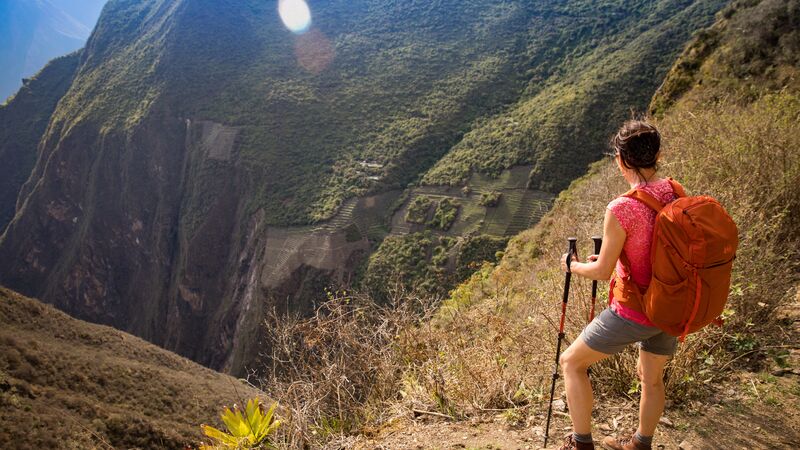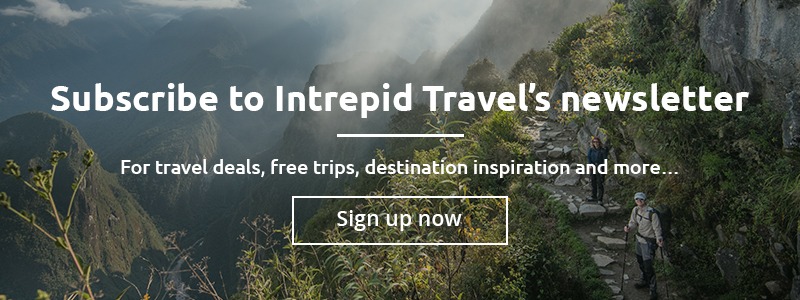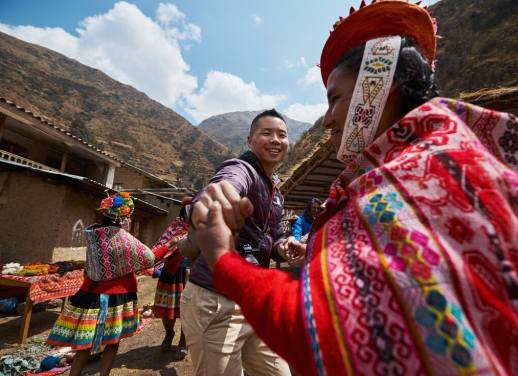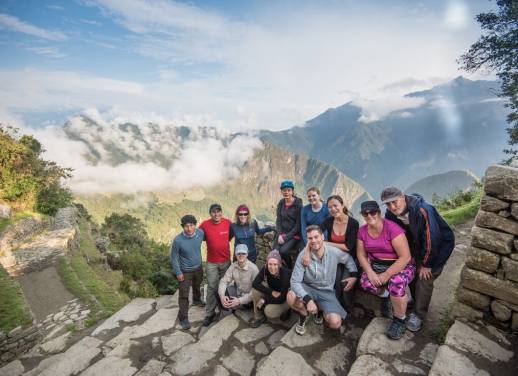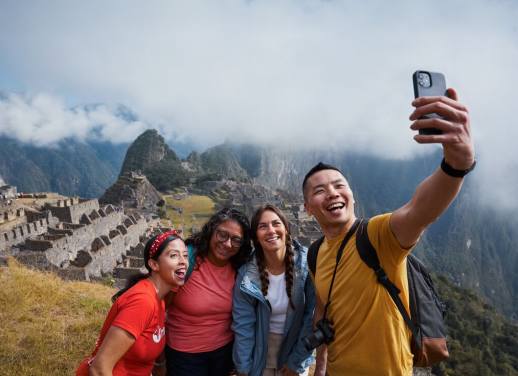“What was the best thing that happened to you in Peru?” asked a grandfatherly gentleman sitting next to me, in a lovely Spanish accent.
“We might as well be friends since we are about to spend the night together. We can decide if we want to exchange phone numbers in the morning, when we land in Miami”, he laughed and winked in a hugely charming way. I told him I had just spent twelve days in his country.
We were queued for takeoff on a tarmac in Lima. The sun had called it a night hours ago. I could still taste the frothy Pisco sour I had at the airport with my last lomo saltado, waiting for our late flight. I loved the way he worded his question, as if he wanted to know what gift his country had given me. Indeed, every country I have ever visited has always given me a gift of some kind. I smiled, my memory flashing a collage of the beautiful places I had seen, people I met in his native Peru during the two weeks since I left my family in suburban Chicago. All of it was special and it would be ridiculous to try to single out one thing as the “best one”.
Some of my friends threw big birthday parties when they reached the impressive half century mark, others went on wine drinking and pampering retreats with friends, a few chose a luxury resort with their husbands. I chose to go to Peru. Alone. I went for physical exertion, sleeping in tents far away from my family and coca tea to celebrate my big five-oh.
I do appreciate a good party, massages and most definitely wine, but there is more to this story, which I was now sharing with my new friend in 12B. I have been wanting to visit Peru and Machu Picchu since I was ten years old, growing up on a different continent than where I live now, after I saw a picture of it in my geography text book and it touched me in a deep, hard-to-explain way. Over the years, I have set out to travel to Peru several times, but every single time something came up that forced me to postpone the trip.
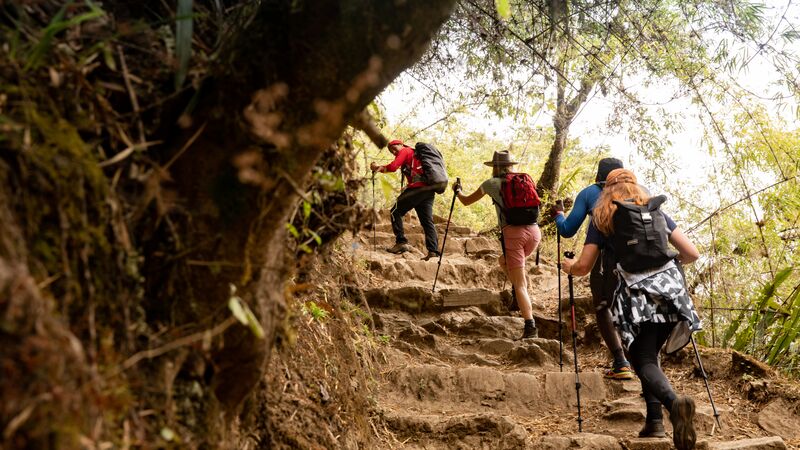 Then, unexpectedly, I learned about a great opportunity to go to Peru with Intrepid Travel, the very year of my big birthday. Could this finally be it? I felt a huge rush of excitement as I read up on the details of the trip, which was to start in Lima, then continue on to Cusco, and most importantly include a visit to Machu Picchu – after a trek to “these other, hard-to-pronounce ruins”. There were a few challenges, mostly related to ditching my suburban life and family of four to dart off to Peru for two weeks on relatively short notice, but I signed up, especially at the urging of my crew: “Mom, you have to do this!”
Then, unexpectedly, I learned about a great opportunity to go to Peru with Intrepid Travel, the very year of my big birthday. Could this finally be it? I felt a huge rush of excitement as I read up on the details of the trip, which was to start in Lima, then continue on to Cusco, and most importantly include a visit to Machu Picchu – after a trek to “these other, hard-to-pronounce ruins”. There were a few challenges, mostly related to ditching my suburban life and family of four to dart off to Peru for two weeks on relatively short notice, but I signed up, especially at the urging of my crew: “Mom, you have to do this!”
A few weeks later, in a window seat of American Airlines, my Peruvian adventure was wrapping up, though everything that “happened to me” was just starting to hit me. I knew I would be processing it for a long time. “I’ve experienced so many interesting and new things, and I did a lot of thinking on this trip, particularly during our trek to Choquequirao,” I replied, thinking out loud.
One has the luxury of a lot of time (something I always lack at home) to contemplate during a multi-day hike. I might have not set out to search for answers about myself, others, the world, the higher good, but the Choquequirao trek gave me a Camino de Santiago-like experience, serving as a pilgrimage of sorts, a unique wellness getaway. Not sure if it was the altitude, the shadowing presence of the great Incas, the coca tea, the distance from my everyday life or simply the fact that I have been around for five decades with many ups and downs along the way, but the trek prompted a perspective on many things and gave me several important revelations and reminders. Some I found on that trail and some came to me afterwards.
FIND OUT MORE ABOUT INTREPID’S 13-DAY CHOQUEQUIRAO TREK TO MACHU PICCHU HERE
Sometimes one thing leads to (an even better) another.
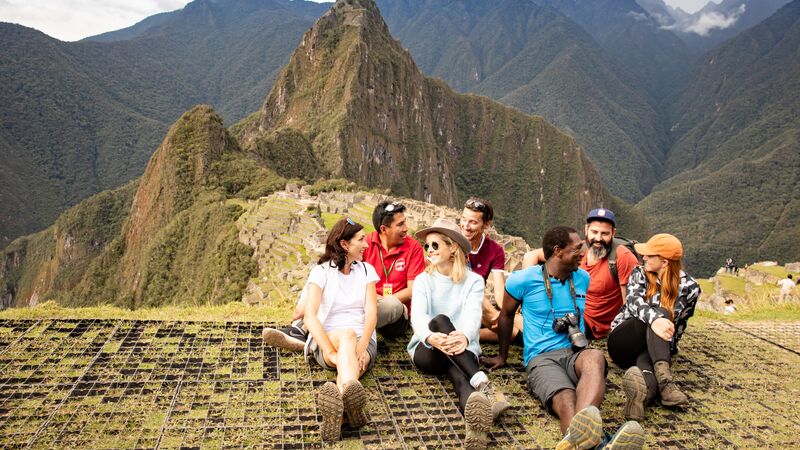 The main reason I wanted to go to Peru was to visit Machu Picchu. There are no words to describe how it felt to finally see it in real life after dreaming about it for forty years. Unlike some tourist attractions I have visited over the years, Machu Picchu actually over delivered and was even more spectacular than I expected. Yes, it was highly personal. Yes, I cried.
The main reason I wanted to go to Peru was to visit Machu Picchu. There are no words to describe how it felt to finally see it in real life after dreaming about it for forty years. Unlike some tourist attractions I have visited over the years, Machu Picchu actually over delivered and was even more spectacular than I expected. Yes, it was highly personal. Yes, I cried.
But as special as this experience was for me, the most profound part of my Peruvian adventure was the trek to Choquequirao, these “other ruins”. They were spectacular, incredibly well preserved and huge. Yet Choquequirao, which some refer to as the “real lost city of the Incas”, is much less known than the world-famous Machu Picchu. After our trek, I fully understood why: the ruins are set in a remote mountain rainforest and there is no train, no bus service, no anything else to take you there. The only way to reach it is by a multi-day high-altitude hike through the Andes, at well over 3,000 meters (10,000 feet). One earns these ruins. Which brings me to my next point.
EXPLORE OUR FULL RANGE OF TREKS TO MACHU PICCHU HERE
The best things in life require effort.
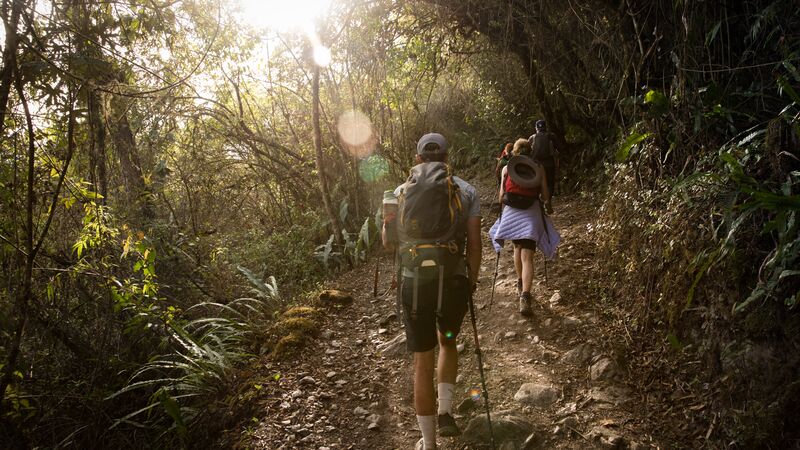 The Choquequirao trek is definitely not a walk in the park. We hiked many hours. For four days. Parts of the trail were steep, the temperature changed from cold to hot, there were rocks to look out for, and many, many mosquitoes. Some members of our group were affected by the high altitude, others had stomach woes, sunburn, sore knees. For some of us (ahem) just going without a shower (or sleeping in tents for several days) pushed us beyond our comfort zone.
The Choquequirao trek is definitely not a walk in the park. We hiked many hours. For four days. Parts of the trail were steep, the temperature changed from cold to hot, there were rocks to look out for, and many, many mosquitoes. Some members of our group were affected by the high altitude, others had stomach woes, sunburn, sore knees. For some of us (ahem) just going without a shower (or sleeping in tents for several days) pushed us beyond our comfort zone.
But it was so worth it. We were rewarded with jaw-dropping scenery, stunning mountain views at every turn, amazing wilderness and, of course, the already mentioned marvelous ruins, plus the fact that we had the place practically to ourselves. Choquequirao is definitely not a tourist destination. During our four days on the trail, we only encountered a few other adventurous travelers and, aside from a few guards or excavation workers, the ruins were ours to explore. It felt tremendously special to be there, as if a privileged secret had been shared with us. That little bit of hardship and endurance to reach it only made Choquequirao more exceptional for us.
Finishing the trek after four days of fairly hard-core hiking reminded me of running a half marathon (I tackled 13.1 miles, twice, at the ripe age of 46 after having never run more than 5 miles in my life). It took several months of training, which required discipline and tested me in many ways, but when I crossed the finish line, I felt a brand new kind of proud. I had a similar feeling after completing the last mile of our trek. In fact, our entire group was beaming, despite (or perhaps because of) the effort we put in to get to the ruins. Nothing meaningful in life comes easy.
INTERESTED IN AN EPIC HIKE? EXPLORE OUR FULL RANGE OF TREKKING ADVENTURES HERE.
In order to grow, you have to push your comfort zone.
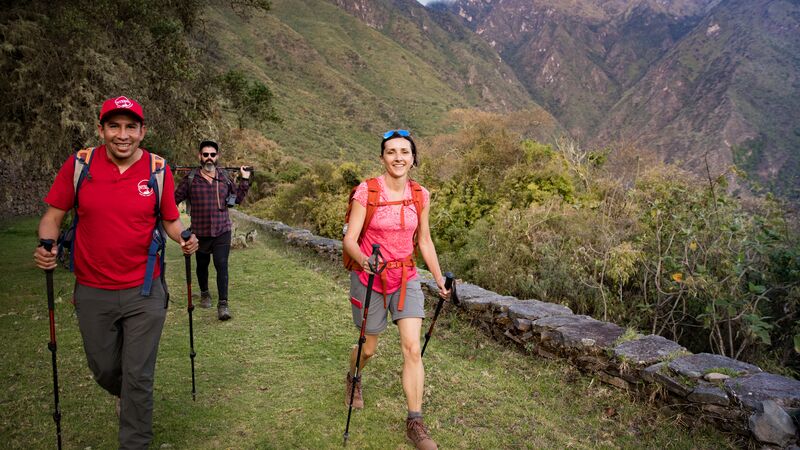 I’m not only talking a physical challenge. It can be anything. In my case, just leaving my everyday life for fourteen days was a real challenge. Going on a trip alone took some guts. As did joining a group of strangers and having a roommate (I haven’t roomed with anybody but my husband in a very long time). Completing a tough trek with people, some of whom were young enough to be my kids, was physically and emotionally challenging. All of these things stretched my comfort zone.
I’m not only talking a physical challenge. It can be anything. In my case, just leaving my everyday life for fourteen days was a real challenge. Going on a trip alone took some guts. As did joining a group of strangers and having a roommate (I haven’t roomed with anybody but my husband in a very long time). Completing a tough trek with people, some of whom were young enough to be my kids, was physically and emotionally challenging. All of these things stretched my comfort zone.
It is easy to underestimate yourself at times, especially if you’re undertaking something for the first time, doing things way out of your “normal” or heading into the unknown. But if we don’t regularly push our limits, we don’t grow, we don’t evolve, we don’t reach our potential. In Peru, I realized that at home, I deliver this message to my kids, but I need to remind myself of the same thing more often.
RELATED: EVERYTHING YOU NEED TO KNOW ABOUT HIKING THE CHOQUEQUIRAO TRAIL
Shared “pain” brings people together.
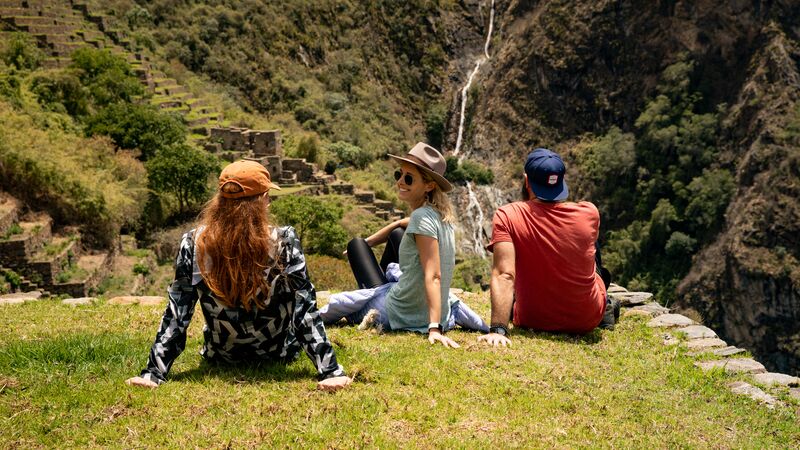 At some point on the trail, I remembered an article I read, citing research that showed shared discomfort or hardship instantly bonds people, increases solidarity and drives cooperation, basically acting as a “social glue” in groups.
At some point on the trail, I remembered an article I read, citing research that showed shared discomfort or hardship instantly bonds people, increases solidarity and drives cooperation, basically acting as a “social glue” in groups.
Our Intrepid group traveled together for a few days in Lima and Cusco before arriving to the Andes, but the trek brought us closer. There was lots of support and encouragement. We cheered each other on. We waited for team members that had slowed down. We shared snacks, water, sunscreen, insect repellent and even toilet paper. Somebody always had a joke or a fun story ready when the energy levels dipped or the next stop seemed still so far away. No matter how different we were or where in the world we came from, we were all in “this” together. It was awesome.
RELATED: PERU’S REAL LOST CITY
Behind every victory is a (great) support team.
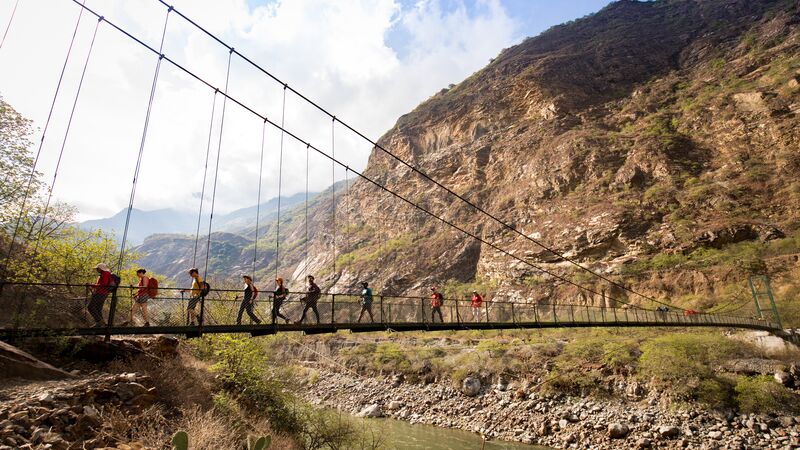 The true heroes of our journey were the people who helped us during our hike. The trekking leader and local guides, who expertly led our journey, setting the pace, instinctively knowing when to take breaks and when to push on despite the fatigue, when to distract us with stories about Peru or when to deviate from the original plan. The team of porters, who set up our tents every night, woke us up each morning with steaming coca tea, then packed our sleeping bags and supplies on horses that delivered it all to the next camp site at the end of the day. The cooks, who sprinted ahead of our group each day, both mornings and afternoons, then waited for us with gourmet meals that helped us recover from the miles we had just conquered and gain energy for those yet to be covered.
The true heroes of our journey were the people who helped us during our hike. The trekking leader and local guides, who expertly led our journey, setting the pace, instinctively knowing when to take breaks and when to push on despite the fatigue, when to distract us with stories about Peru or when to deviate from the original plan. The team of porters, who set up our tents every night, woke us up each morning with steaming coca tea, then packed our sleeping bags and supplies on horses that delivered it all to the next camp site at the end of the day. The cooks, who sprinted ahead of our group each day, both mornings and afternoons, then waited for us with gourmet meals that helped us recover from the miles we had just conquered and gain energy for those yet to be covered.
We couldn’t have done it without them. I vowed to make a greater effort to recognize people who might not be in the spotlight on the stage; without them behind the scenes, the show would fall apart.
Solo travel is surprisingly enjoyable, rewarding and liberating.
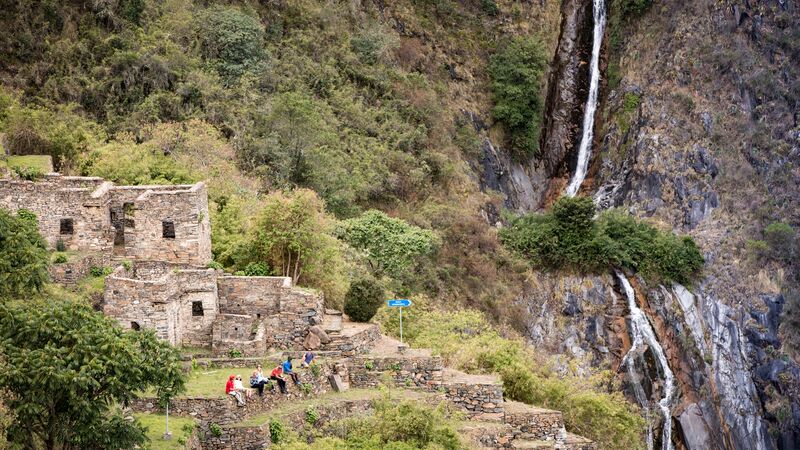 I was part of a group, but what I mean by “solo travel” is traveling without a spouse, partner, family or friend. If you are reading this and happen to do a lot of solo travel already, you may be thinking “duh”, but for me, traveling alone is not a very familiar concept.
I was part of a group, but what I mean by “solo travel” is traveling without a spouse, partner, family or friend. If you are reading this and happen to do a lot of solo travel already, you may be thinking “duh”, but for me, traveling alone is not a very familiar concept.
I used to travel by myself as part of my corporate job, but those trips were quick, filled with meetings or focus groups; not the kind of travel that “counts”. These days, I usually travel with my family of four; exploring the world together and learning about other places and cultures is one of our favorite things to do.
At first, being without them felt strange, but at some point during our trek it hit me how much I enjoyed being on my own. Sure, there were moments I missed my family, usually because I was having experiences that I would have loved to share with them, but being by myself was also incredibly gratifying. I did not have to worry about anybody but me and I only had myself to rely on. Solitude was both liberating and invigorating. I decided I need to do more solo travel in the future.
RELATED: PERU’S MUST-VISIT HIDDEN GEMS, ACCORDING TO A LOCAL LEADER
But back to my seat mate’s question. I don’t care how corny it sounds; I was filled with gratitude for simply being on this planet and being alive every single day of my trip. It was impossible not to be. Our journey through the mountains of Peru was a great reminder that our planet is remarkable. The landscape we covered was incredible and ever-changing: hilly grasslands dotted with lilies, desert-like stretches with statuesque agave plants, pebbly river beds lined with yellow flowering cacti and lush rainforest with giant ferns, fuzzy hanging vines and purple orchids. I saw a flying condor, a giant tarantula, baby llamas, colorful butterflies. I witnessed beautiful sunrises and gorgeous sunsets. At night, I gazed at some of the biggest and brightest stars I have ever seen. And, of course, there were those mind-blowing Inca ruins. I vowed to keep traveling, alone, with my family, with a group… in any shape or form… and continue to experience as many places I can in my lifetime.
“It sounds like it was quite a trip,” said my new friend in the seat next to me, smiling. “It was,” I nodded and smiled back even bigger. We did not exchange phone numbers in Miami, but he gave me his email address in case I go back to Peru and need help.
Interested in the trek of a lifetime? Join us on an epic adventure along the Choquequirao now. our trek to Choquequirao.
All photos by Liam Neal.

